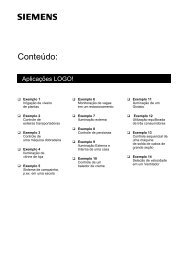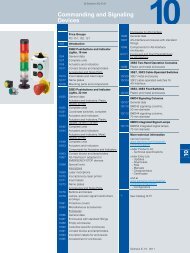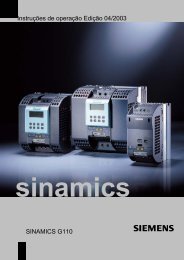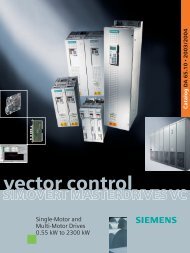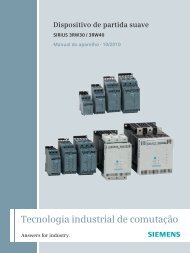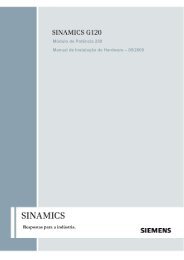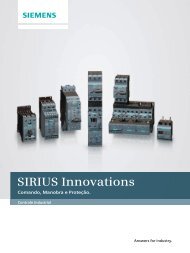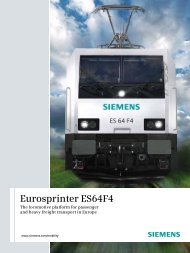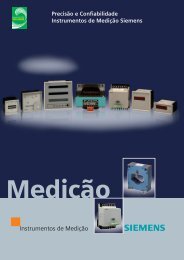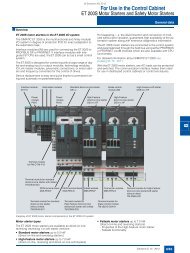SIROLLCIS CM Solutions for cold rolling mills - Industry - Siemens
SIROLLCIS CM Solutions for cold rolling mills - Industry - Siemens
SIROLLCIS CM Solutions for cold rolling mills - Industry - Siemens
Create successful ePaper yourself
Turn your PDF publications into a flip-book with our unique Google optimized e-Paper software.
Rolling strategy<br />
Process control models<br />
Set-up calculation<br />
(“pre-calculation“)<br />
Process<br />
automation<br />
Physical models<br />
Neural networks<br />
to adapt<br />
physical parameters<br />
“Post-calculation“<br />
Adaption<br />
Basic automation<br />
Measured data<br />
acquisition<br />
Analytic process models in combination with neural networks<br />
Process automation server<br />
The strip-temperature model<br />
Strip temperature is modeled and<br />
controlled <strong>for</strong> two reasons: to produce<br />
specific material properties and to avoid<br />
excessive lubricant temperatures that<br />
could cause surface defects.<br />
The strip-temperature model<br />
incorporated into <strong>Siemens</strong> VAI process<br />
control employs a finite-difference<br />
method based on Fourier’s equation of<br />
heat conduction.<br />
The roll-temperature and<br />
roll-wear model<br />
The roll-temperature and roll-wear model<br />
calculates the time-dependent thermal<br />
roll contours (roll contour – diameter as a<br />
function of axial position) of all the rolls<br />
in a mill stand: the work rolls,<br />
intermediate rolls and back-up rolls.<br />
The roll contour is also affected by wear,<br />
the second aspect factored into the rolltemperature<br />
and roll-wear model.<br />
<strong>Siemens</strong> VAI has developed a special<br />
online solution method to optimize the<br />
tradeoff between precision and speed of<br />
calculation.<br />
The material flow and gap model<br />
Material flow across the width of the strip<br />
as it passes through the roll gap provides<br />
the data <strong>for</strong> calculating strip flatness,<br />
strip profile and edge drop.<br />
The roll gap model calculates threedimensional<br />
de<strong>for</strong>mation in the roll gap.<br />
Small as it is in <strong>cold</strong> <strong>rolling</strong>, lateral flow is<br />
an important factor in determining strip<br />
shape, particularly at the edges of the<br />
strip.<br />
Speed optimization<br />
Flexible production planning can result in<br />
the necessity to run different process<br />
speeds in the pickling plant and tandem<br />
mill. Speed optimization aims to<br />
maximize the production rate while<br />
maintaining the high quality of the<br />
finished strip. This function also covers<br />
planned stops of mill sections, e.g. due to<br />
trimming knife changes or roll changes;<br />
measured values and signals from the<br />
line; technological prescriptions;<br />
individual strategies; and reaction to<br />
detected strip defects.<br />
Coil building<br />
SIROLL CIS <strong>CM</strong> enables data management<br />
and provides set-point <strong>for</strong> “m to n coil<br />
handling”. An incoming coil consisting of<br />
m welded sections can be rolled and<br />
divided to n outgoing coils. At the end,<br />
SIROLL CIS <strong>CM</strong> incorporates advanced cut<br />
control <strong>for</strong> building coils. The options<br />
include manual cutting, inspection<br />
cutting, and jumbo-coil <strong>rolling</strong> by cut<br />
criteria such as coil weight or coil<br />
diameter. The ability to change target<br />
gauges on the fly (flying gauge change)<br />
is essential <strong>for</strong> cost-effective continuous<br />
<strong>cold</strong> <strong>rolling</strong>.<br />
21



